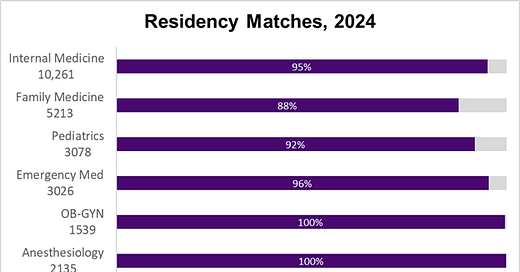Source: National Residency Matching Program, March 15, 2024 LINK
The third Friday in March is “Match Day,” when those who will graduate from medical school this spring find out where (and whether) they were accepted to a residency training program. Programs rank their applicants; prospective trainees rank programs to which they have applied; and a computer matches to optimize choices for all programs and applicants.
Many newly minted physicians will travel to new parts of the country, and some will have to scramble if they did not “match” in any of their chosen programs. Results of this year's residency match have emergency medicine leaders breathing a sigh of relief; far fewer positions remained unfilled this year compared to 2023. Leaders of obstetrical and gynecology programs were also worried that the Dobbs decision and inability to train for a full scope of women’s reproductive procedures would lead to unfilled residency slots in states with restrictions. In fact, virtually all obstetrical slots were filled.
The situation is much more dire for primary care. Eight percent of pediatrics positions went unfilled, as did 12% of family medicine residency positions. Internal medicine, which includes many specialties as well as adult primary care, saw 95% of its positions filled.
Source: National Residency Matching Program, March 15, 2024 LINK
About one-quarter (24%) of those entering pediatrics, about one-third (32%) of those who matched in family medicine, and 41% of internal medicine first-year residents (also known as interns) are either foreign medical graduates or US citizens who got their degrees from non-US medical schools. The primary care shortage would be far worse, especially in rural communities, if we did not have substantial physician immigration.
Implications for employers:
- Emergency departments are overflowing all over the country, so a full complement of new emergency medicine trainees could help us be adequately staffed for emergency care in the future.
- Full matching in obstetrical programs around the country is also good news as we seek to improve maternity care.
- Shortfalls in residency matching in primary care point to a need for innovations that will better use technology and non-physicians so that the needs of employees and their families can be met.
Thanks for reading. You can find previous posts in the Employer Coverage archive
Please subscribe, “like” and suggest this newsletter to friends and colleagues. Thanks!
Tomorrow: Transgender people often feel discriminated against when seeking medical care





Can you later pivot from primary care work (after completing general internal medicine training) to something else as a European physician?
I'm not seriously asking for myself, I'm too old to switch continents. But marketing that route would increase the number of physicians in the US, which would lead to some trickling down to primary care on a longer-term basis.
Alas, I don't think primary care shortage can be filled by physicians, maybe mid-levels is the answer? Or blasting open the doors to med school, so you don't have to be outlier on diligence, motivation, or talent to get in? That would allow for recruiting people whose traits don't make them strongly prefer the hospital specialties.